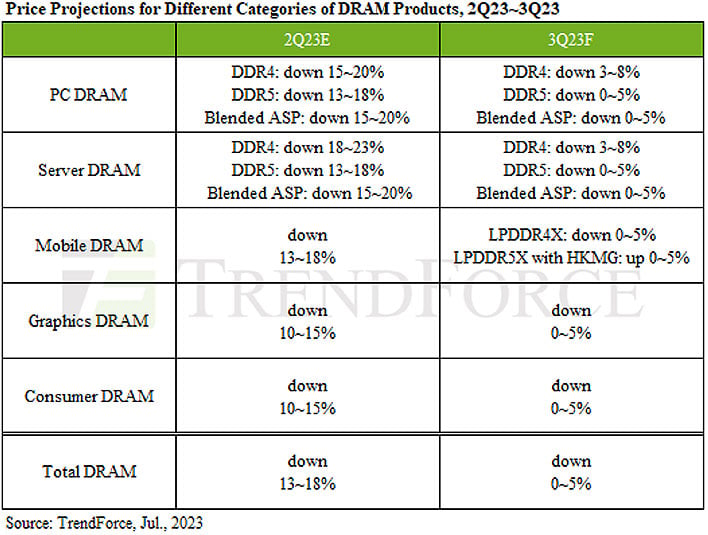It's all about timing when it comes to PC memory and we're not just talking about latency settings—
when you pull the trigger on a new memory kit can make a big difference on the value proposition. Fortunately for consumers, DDR5 and DDR4 memory pricing is
still on a downward swing, though it's no longer free falling and could be about to level off.
The fortune tellers at TrendForce released a report indicating that production cuts and typical seasonal demand could slow the decline in the average selling price (ASP) of DRAM to 5 percent at most, and perhaps even cause pricing to hold steady in the third quarter of 2023. That said, suppliers are still weathering the storm, though your chance to pounce before prices begin to creep back up may be running out.
"Despite suppliers’ concerted efforts, inventory levels persistently remain high, keeping prices low. While production cutbacks may help to curtail quarterly price declines, a tangible recovery in prices may not be seen until 2024," TrendForce says.
Looking specifically at DDR4 in the consumer space, TrendForce says "aggressive purchasing by several OEMs" helped alleviate some of the inventory pressure that the top three suppliers (including
SK hynix) have been experiencing. It's still not enough to complete offset the oversupply situation, though, and the market research firm expects consumer DDR4 pricing to decline anywhere from 3-8 percent this quarter.
The situation is somewhat murkier when it comes to cutting-edge DDR5 memory. Suppliers have made a concerted effort to stop the bleeding, and combined with "unmet buyer demand," TrendForce anticipates prices staying flat or modestly dropping by up to 5 percent.
"The consumer DRAM market continues to grapple with oversupply. Nevertheless, suppliers are progressively cutting back production, the benefits which are expected to materialize in the third quarter. Given the substantial operating losses incurred by these suppliers, these factors should curtail the decline in ASP of consumer DRAM to 0-5 percent in 3Q23," TrendForce says.
It's the same situation across the board, including server, mobile, and graphics DRAM. In each category, hefty declines observed during the previous quarter are expected to slow way down in the current quarter. For example, DDR4 pricing dropped 15-20 percent last quarter, versus an expected 3-8 percent decline this quarter. DDR5, meanwhile, fell 13-18 percent last quarter and is expected to decline just 0-5 percent this quarter.
Should these projections come true and ultimately lead to a recovery next year, memory pricing could be on the verge of going back up. The interesting wrinkle is that
DDR5 is still in its relative infancy. We've already seen DDR5 prices fall off a cliff since debuting at retail with Alder Lake, but as the market continues to shift away from DDR4, we would expect prices to remain stable. We'll see if that happens.
If you haven't shoppe for RAM in a while, you might be surprised to see how much it's declined in the past couple of years. Here's a small sample size of what the current landscape looks like...
- 32GB Corsair Vengeance RGB DDR5-5600: $102.99
- 32GB G.Skill Trident Z5 RGB DDR5-6000: $104.99
- 32GB Teamgroup T-Force Vulcan DDR5-6000: $79.99
- 32GB G.Skill Flare X5 DDR5-6000 w/ AMD Expo Support: $91.99
- 64GB Corsair Vengeance DDR5-5600: $169.99
- 32GB Teamgroup T-Force Vulcan Z DDR4-3200: $55.99
- 32GB Teamgroup T-Force Vulcan Z DDR4-3600: $57.99
- 32GB Corsair Vengeance RGB Pro SL DDR4-3600: $79.99
- 32GB Patriot Viper Elite II DDR4-4000: $69.99
- 64GB G.Skill RipJaws V DDR4-3600: $122.99
These prices are probably close to as low as they're going to get, if TrendForce's latest
DRAM report is any indication, though time will tell. Some of these also represent massive price declines. For example, the 64GB Corsair Vengeance DDR5-5600 kit that now sells for $169.99 was going for $550 a year ago. Condolences to any early adopters who splurged at the time.


